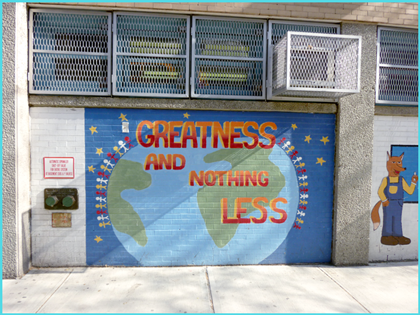|
Effective Teaching...
by Harry and Rosemary Wong |
|
To print: Select File and then Print from your browser's menu
|
Achieving Greatness:
Alain L. Locke Elementary School-P.S. 208, Part 2
This is a school you would want to teach in. |
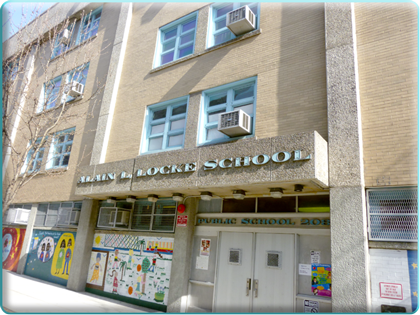
This is a school the kids want to be in.
P.S. 208 – Alain L. Locke Elementary School, Harlem, New York
Alain L. Locke’s success has attracted students from all over New York. Some students commute from Brooklyn and the Bronx on a daily basis. These students travel anywhere from half an hour to an hour to get to school every day—all because the parents and the students are pleased with the school. |
|
Students Come First
Alain L. Locke Elementary School teaches greatness (click here to read how in last month’s column). More important, the school achieves greatness and this is without Race to the Top funds. It’s a place where “Students and staff alike will hold themselves accountable to ‘greatness and nothing less.’”
 |
The steadfast administrators are Susan Green (right), principal, and Jackie Colon (left), assistant principal. Susan sets the tone and policy of Locke School. She states:
All decisions are determined by the needs of students, not by the convenience of adults. We can't teach mediocrity and then hold the children to achieve high standards and produce greatness. |
|
- Teachers must be reflective and transparent about what they do not know and be willing to do the work to improve in areas of weakness.
- No student deserves to suffer or be stagnated due to their teachers' inabilities
or inhibitions.
- The work we do with our students today will impact not only their futures, but ours as the adults as well.
- As educators, we made a choice to be in this field; to influence lives, and therefore, cannot afford to give children anything less than the best all of the time.
|
| Jackie is the driving force behind the culture and professional development of the school. She shares: |
| |
School-wide and classroom routines are essential to student success and ultimately student learning. A culture of consistency must be established within the first days of school. When procedures and routines are established, students will know what is being expected of them every day.
To quote The First Days of School, "A procedure is what the teacher wants done, a routine is what students do automatically." When students have clear expectations, the routines come naturally making the procedure that much easier to come across. Hence, a smoother managed classroom will result in student learning that can and will take place. |
Together, Susan and Jackie have created a haven of calm, caring, and learning for anyone who walks through the doors of Locke School.
You Are Speechless
Like so many schools in New York City, they are given impersonal numbers along with the designation of Public School, such as P. S. 208. P. S. 208 is not a KIPP school or is it a Harlem Success Academy, both very fine charter schools that have a strong media following. P. S. 208 may be a generic name and a number, but it has a personality. It has a culture. It has a name. It is P.S. 208 Alain L. Locke Elementary School, named after the first African American to win a Rhodes Scholarship.
Come with us through the doors and see what it is like to become part of the Locke School community.
You were hired the day before school opened and really thought you had reported to the wrong school in New York City. You are at Alain L. Locke P. S. 208 and all students qualify for free or reduced-price lunch, are mostly all minorities, and come from challenging home or neighborhood environments, but that is irrelevant.
As you go to your classroom you pass a sign in the hall:
 |
You think nothing of it, but you do see a silent signal used. Having come from observing classrooms in other schools during student teaching where you see chaotic classrooms and teachers yelling at students to be quiet, you hold up two fingers and your entire class comes to a hush.
You then say, “Good Morning, boys and girls” and they all respond, “Good Morning” with your name.
You are about to collapse from disbelief, but you have to hold on to your composure and look like you are the most put together teacher on the planet. |
You are so shaken with amazement you are speechless—as the class watches you for your next move. You don’t move; you’re frozen in disbelief. Finally, the students say, “Where’s the bellwork?” “Where’s our agenda?” “We had them last year.” |
You are so moved by the courtesy and the desire of the students to work—and they work hard at this school—you truly believe you were given the wrong address and ended up at the wrong school.
 |
You quickly peek in the classroom next to you to check your disbelief and see the students orderly, engaged in learning, and seemingly all know what to do. Your students are doing it, too, and you don’t know why. This is because there are school-wide procedures creating a culture of consistency at
Locke School.
(Click here to see an example of a culture of consistency in another school.)
|
Monica Burns
You watch Monica Burns, a fourth year teacher, interact with her class as she conducts a lesson. The students hold up their hands if they want to speak and while others are talking, they pat themselves on the head as a signal they concur with what has been said. There is no yelling. No frantic waving of a gaggle of hands. No students blurting out. No put-downs of other student’s responses.
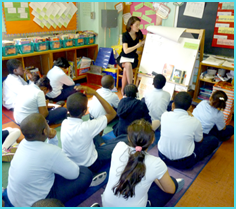 |
Even with an ADHD student or two, Monica teaches class calmly. She conducts class sitting patiently in her chair with only a flip chart to use, while there is calm and happy, yet engaged, learning in her class.
Monica teaches a procedure where the student’s tap their own head when they agree with an answer provided by
another student. |
She teaches this signal in the start of the year when they begin having whole class discussions at their seats or on the rug. These are the reasons she finds this signal effective:
- Gets less outgoing students involved in a discussion.
- Keeps the whole class active even when they are not providing an answer themselves.
- Unites students around a common purpose.
- Supports accountable talk prompts such as, "I agree with __(name)__ because . . . "
- Adds to a discussion by identifying students who do not support another student's answer. ("I noticed that you do not agree with __(name)__.")
- Combats a student's frustration from not being called on; an alternative to slamming one's hand on a desk or sighing heavily. ("Show me that you had the same
answer . . . ")
- Stops students from calling out, "I knew that!" or "I had that answer!"
- Identifies who is not paying attention; holding all students accountable for participation.
- Transferable to discussions in all subject areas.
|
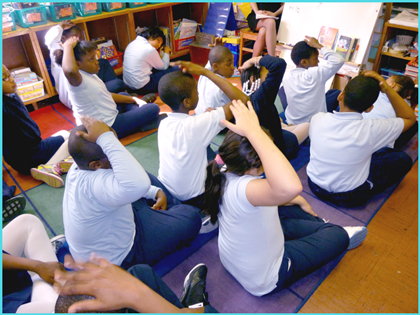 |
For instance, her class is working on teaching fact families. She asks students to describe the fact family for 3 + 4. One student offers a response:
Student: “4 + 3” (This is where the teacher looks to make sure everyone has tapped their head in agreement.)
Student: “4 – 3” (If a student does not tap |
| his or her head, the teacher follows up by asking a clarifying question.) |
Teacher: “I saw that you did not agree that 4 – 3 is part of this fact family. Could you explain your thinking?” (Student should be able to support why he or she agrees or disagrees with another student’s answer.)
The Head Tap Procedure is only one of many that keeps Monica’s classroom running smoothly.
When students work independently, Monica has procedures for quiet ways to signal when they are finished. When they are reading, they are asked to close their books and lay them on their desks. Or when they are writing, they signal by laying their notebooks open on their desks with their pencil in the fold.
She also has “Rug Time” procedures. When it is time for group discussions, students move to a rug with colored rows. They know exactly where to sit, and how to sit—with their legs crossed, facing the board.
When she wants the students’ attention, she simply says, “One-Two-Three. Eyes on Me.” And every student is attentive and focused on her.
To add to these procedures, Monica’s classroom is also organized in a way that her expectations are displayed clearly for all her students. On the blackboard, Monica has sections set aside for the Daily Schedule, the Paper Header (which is consistent school-wide), and What We’re Doing Today.
These procedures all help Monica’s classroom to run smoothly, quietly, and efficiently.
Guided Reading
A Guided Reading bulletin board is posted in one of the hallways for everyone to see—teachers, students, and parents. The board is the creation of the assistant principal, Jackie Colon.
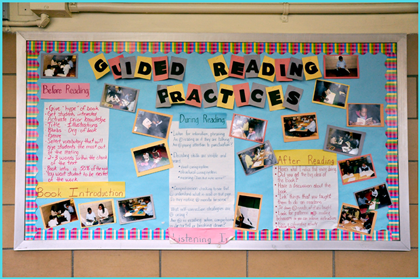 |
All it takes for a school to achieve success with its students are
- Administrators who know how to teach effective instruction.
- Teachers who collaborate with laser focus on student learning and achievement.
|
Guided Reading is a collaborative, school-wide initiative. All teachers are in Guided Reading groups, a system adopted by the school community when they recognized the need to improve reading by differentiating instruction according to students' ability.
Guided Reading is based on a student’s reading levels that are determined after teachers have conducted what is called a Running Record Assessment, using the Fountas and Pinnel Reading System.
A running record is a continuous formative assessment used to keep a record of and monitor each student’s oral reading progress. Running records help teachers measure students' progress, plan for future instruction, provide a way for students to understand their progress, and communicate progress to parents and the school community. Examples of running record forms can be found by Googling “running records.”
The bulletin board is used for Professional Development purposes. The board reflects what should take place at various stages within a Guided Reading session, such as:
- What is Guided Reading?
- How to group students
- How to provide Guided Reading instruction
- How to conduct Running Record assessments
Teachers are observed in Guided Reading. Then, they are taken to the board that provides a visual for the teacher. With the feedback from the observation, the teacher is validated on what is being done right and what progress the teacher needs to take next.
Click here to see the procedures used before, during, and after Guided Teaching instruction.
Visitations are made to observe teachers that are teaching Guided Reading effectively. The teachers then work collaboratively to continuously hone the procedures to better and better help the students.
They Have Achieved Academic Greatness
Locke School keeps striving for Greatness. It’s a journey that has no end with jaw dropping vistas along the way. Locke School has seen a steady increase in student performance over the past three years. On the New York State Math and English Language Arts exams, they have seen a 16% and 20% increase, respectively, in passing grades.
School Year |
Math |
English Language Arts |
2006-07 |
58.1% |
38.6% |
2007-08 |
64.5% |
43.2% |
2008-09 |
74.5% |
57.6% |
The students at Alain Locke School depend on this school and their teachers to provide the support, stability, and encouragement they may not get from other aspects of their lives. The culture at Locke School gives students the self-confidence to become successful adults.
A School with a Purpose
As we watched the students recite the Alain Locke School mantra, it was evident there was something very different about these children. They had a purpose. These students started the day with a very clear understanding of what they are about to accomplish. They walked into the building with their needs met and a purpose for the day.
What was that purpose? It is very apparent to anyone who listens:
“Today I will do more,
I will learn more,
I will be more,
Than anyone ever thought I could.
Today I will strive for GREATNESS and nothing less.”
| Susan explains that when you teach, you are modeling for children. This demands a certain level of professionalism and accountability. As a result, all of the teachers at Locke Elementary take great pride in what they do. “I teach greatness . . . and nothing less.” |
| Least you forget what your purpose is for students, click here to visit Locke’s website or click here to read their blog. Better yet, take an early morning walk through the streets of Harlem and you’ll hear the Locke School children reciting their mantra—waking up the neighborhood, waking up your senses, rejuvenating your soul, restoring your passion, and making you stand tall that you are part of the greatest profession in the world—you are a teacher. |
© Harry K. Wong Publications, Inc. Permission to print and share with the profession is granted.







